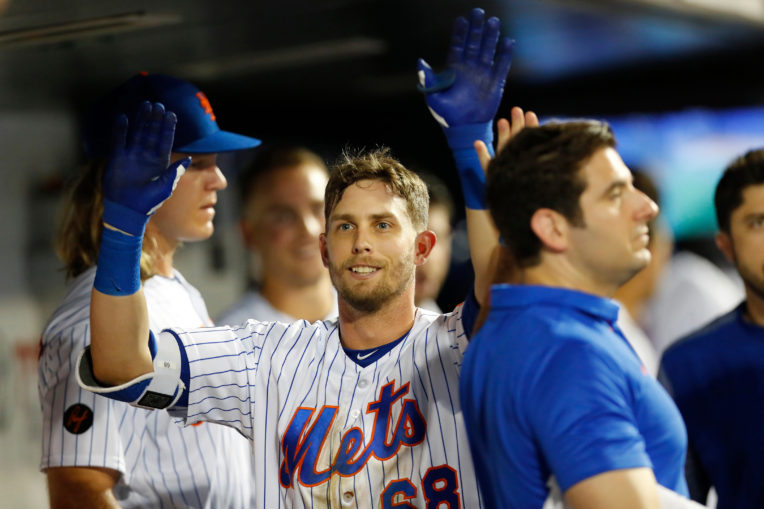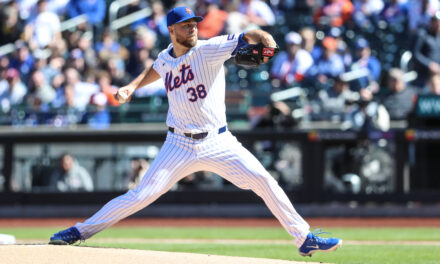
It’s been a long and winding road for recent New York Mets callup Jeff McNeil.
McNeil was drafted as a shortstop in the 12th round of the 2013 MLB draft out of college at the age of 21. At the time of the draft, he was seen as someone who was unlikely to ever make it as an everyday player, and had a ceiling of maybe becoming a utility player.
He was highly regarded for his contact skills, as he struck out just 44 times in 581 college at-bats. His approach was seen as very simple, with a short swing that he would just slash at the ball without a ton of patience, making a lot of contact and collecting a lot of singles in the process. Defensively, he’s never been fantastic anywhere but has always provided versatility around the infield.
For the first few years of McNeil’s professional career, he played pretty much how the scouting report described him. From 2013-2015, McNeil hit .305/.379/.389 with a 10.7% strikeout rate while spending time at second base, third base, shortstop, first base, and center field. In this time span, he had made it from the Rookie-level Kingsport Mets all the way up to the Double-A Binghamton Mets (now named the Binghamton Rumble Ponies).
It seemed as though he was becoming everything the Mets could have hoped he’d become, but with the limited power and mediocre glove, he really didn’t stand out.
However, 2016 would be a step back for McNeil, mostly due to injuries. He dealt with a double sports hernia and a hip labrum tear, which limited him to only three games that season.
In 2017, he missed a bunch of time with a groin injury, limiting him to 48 games that year. In the 194 plate appearances he had, he was still himself, with a .295/.351/.432 slash line along with a solid 14.9% strikeout rate. He had a slight increase in power, which led to a career-best .782 OPS (albeit in a much smaller sample). Plus, after hitting the ball with much more authority in High-A St. Lucie, to the tune of a .864 OPS and .152 ISO, he was promoted to Triple-A for the first time.

But coming into 2018, it’s no secret that things were really not looking too great for McNeil. He was about to turn 26 and had only played 51 combined games over the past two seasons. He had also struggled in the notoriously hitter-friendly Cashman Field, posting just a .295 OBP and .661 OPS for the Triple-A Las Vegas 51s. He still had good contact skills and was starting to develop more power, but he was starting to look more and more like a career minor leaguer mold of player.
McNeil started the 2018 season for the Double-A Binghamton Rumble Ponies, and immediately, something clicked and he took off faster than he had ever taken off before. Finally healthy, McNeil posted a robust .994 OPS in the month of April, with an insane .344 ISO. For reference, Babe Ruth‘s career ISO was .348, which is still the best mark of all time. This was especially uncharacteristic and unusual for a guy in his mid-20s who was never much of a prospect and had always been a contact hitter with limited power.
With his track record of never being a very powerful hitter and the hot streak being only a 16-game sample, it was certainly right to be skeptical of this newfound success, and some regression had to be in store for the future. Right?
Nope. At least not yet. In May, McNeil played 28 games for the Rumble Ponies and got even better, hitting .340/.407/.660. The extra-base hits were still coming at that elite level, and his walk rate was higher than it had ever been at 8.7%. He kept mashing through May into the middle of June, when it was clear that a promotion was not only in order, but probably overdue.
McNeil’s ridiculous season continued in Triple-A, as he just never fell into a slump and kept destroying the baseball nonstop. He posted OPS’s over 1.000 in both June and July, and Mets fans everywhere were just begging for him to be called up. Although later than some may have liked, the Mets finally selected his contract from the 51s on July 24.
So where could this dramatic change have possibly come from? Well, there’s no obvious answer, but one of the most telling signs has been McNeil’s increased fly ball rate. Here’s a chart of his fly ball rates by year, along with his corresponding ISO and wRC+, to see how his fly ball rates correlate with his power output and overall hitting.
| Year/Level | FB% | ISO | wRC+ |
| 2013 (R) | 35.3 | .079 | 142 |
| 2014 (A) | 30.7 | .129 | 142 |
| 2014 (A+) | 36.7 | .072 | 90 |
| 2015 (A+) | 36.4 | .071 | 133 |
| 2017 (A+) | 38.3 | .152 | 154 |
| 2018 (AA) | 49.7 | .299 | 181 |
| 2018 (AAA) | 33 | .232 | 164 |
For the most part, an increased fly ball rate has resulted in a much higher ISO and wRC+, with the change in ISO being the more dramatic between the two. McNeil’s success in Double-A this year also came with a career-low 30.5% ground ball rate, so that along with the career-best fly ball rate is a clear recipe for success. Interestingly, however, he only had a .316 BABIP in Double-A, yet still hit like a monster, which shows just how good of a hitter he was.
While it’s undeniable that McNeil continued his insane hitting throughout his 143 plate appearances in Triple-A this year, his success in Las Vegas looks a bit flukier. The ISO was still great at .232, although it was a regression from his .299 mark in Binghamton. As you can see in the chart, his fly ball rate actually dropped by 16.7% from Double-A to Triple-A, and that came along with a career-worst 50% ground ball rate. What helped him out, however, was an insane .394 BABIP, which is helped out a lot by the hitter-friendly Cashman Field. And with that ground ball rate, had he stayed in Triple-A longer, he likely would have regressed. Despite all this, a .368 average and 1.027 OPS at arguably the second hardest level of baseball in the world is nothing to scoff at.
Plus, he posted his career-best walk rate at 9.8% in Las Vegas, surpassing his career high set in Binghamton earlier in the year at 9.1%. He has become much better at taking pitches than in the past, and this has been another major aspect of his improvements.
Since being promoted to the Majors, McNeil has been perfectly solid but has come back to Earth a little bit. He’s hitting at about league average with a .267/.345/.400 slash line and a 106 wRC+. In the field, he’s played mostly second base, which the Mets view as his best position, and has been solid but unspectacular there, pretty much as expected.
His strikeout and walk rates are both very good at 9.3 and 7.0 respectively, although his ISO has dipped to .133, which is more reminiscent of how he hit earlier in his career. However, you can expect improvements in the future as his .277 BABIP goes up and as he just figures out and gets used to Major League pitching. He’s very experienced and has hit at pretty much every level, so the time for adjustment may not be as long as it would be for a younger hitter.

While some scouts are still skeptical due to his long track record of never hitting for power, as well as his age and lack of prospect status, many others see a Daniel Murphy–type of player in him. The prospect of this even being a possibility is a reason for Mets fans to watch this guy and get excited about him.
While McNeil may not be a big-name prospect, his sudden rise this year has grabbed many people’s attention and he has worked his way into the conversation for the Mets’ future plans. With the Mets completely out of the playoff picture, McNeil has been getting a chance to play pretty much every day, so it’s basically an audition for him right now so the Mets can see what he can do. Now is the time to shine for Jeff McNeil.















